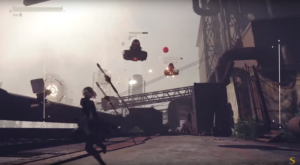For what it’s worth, this game took me an entire year to get through. The more important note here, however, is that I didn’t do it on my own. Since my access to the PS4 is limited by multiple factors, it takes me forever to complete games on it.
Thankfully, the game has been out long enough that I was able to experience a playthrough for the parts of the game I could not get to myself.
What I found was a masterpiece.
“Nier: Automata” is a game that brought me to tears with identical endings on the first two routes despite the fact I already knew how it would end. The raw emotion of the scene and the build-up to it were nothing short of spectacular and awe-inspiring.
From there on, the next parts of the story are a trip down several paths that could definitely land someone in an existential crisis in one of the most imaginative and heartbreaking ways possible.
I’m not here to talk about all the reasons why “Nier: Automata” made me cry; not entirely, at least.
Before I dive in, it would probably be for the best if I give a little information about the game.
“Nier: Automata” begins in the far future where humans have moved to the moon and are dwindling in number. The story itself focuses on YoRHa units 2B and 9S as they traverse the land on various missions and meet allies, converse with those of the Resistance, and cut down the machine threat that has existed as their mortal enemies for centuries.
As a side note, the game is tough; I set it on normal difficulty and even then I’ve died several times over and it can be quite merciless at times gameplay-wise.
However, I believe the ample opportunity to level up and gain upgrades along with heavy customization make up for it and I was mostly just a fool that ended up skipping side quests to power through the story.
 That’s one notable thing I truly enjoyed about witnessing someone else playing the game; he actually did all the side quests and I was able to see what I missed from my need to see the full story as opposed to seeing all aspects of the world Yoko Taro crafted.
That’s one notable thing I truly enjoyed about witnessing someone else playing the game; he actually did all the side quests and I was able to see what I missed from my need to see the full story as opposed to seeing all aspects of the world Yoko Taro crafted.
While some games have side quests that are only there for extra experience points and items, the ones within “Nier: Automata” provide more background to the game that makes it more enjoyable for the player.
For example, one side mission educated the player on a special type of YoRHa unit known as the ‘E’ type, which pops up in the main story later on. However, even without that additional knowledge, the player would still understand the progression and the importance.
Unfortunately, I can’t talk much about the game itself without entering spoiler territory. To go into this game as anything other than blind would be a mistake. There are hours of the game to go through and find everything before the player can see the final picture that is being painted for them.
Even so, the effort and time are entirely worth it to see these androids through their journey in the game. I can highly recommend this game to anyone, especially those looking for a game that can be taken slowly in order to explore the environment and learn more about the colorful cast in such a dreary vision of the future.
Yoko Taro’s “Nier: Automata” has set a mark for games that run in the same vein. To put as much dedication and heart into a story with such impact that it can take your breath away is awe-inspiring and, as a writer, I can only hope I may reach this level in my own works.
Erika Brandenburg
Arts and Entertainment Editor

